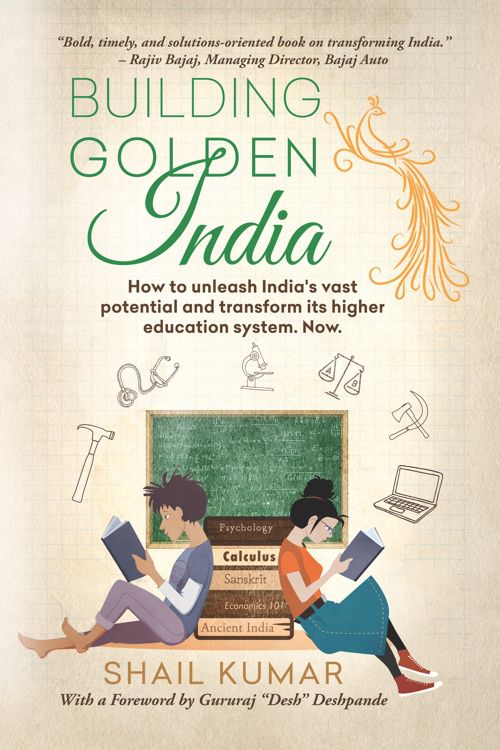Lagging far behind developed nations in university rankings, India must transform its ailing higher education system.
The writing is on the wall. India’s higher education system is in crisis and everyone is paying a hefty price for it: students, parents, industry, society and the nation.
Private coaching costs of preparing for premier institutions such as the Indian Institute of Technology (IIT) have soared by 250 to 500 times in the last 30 years. Over the same period, the time required to prepare for the IIT Joint Entrance Examination (IITJEE) has gone up from a one-year grind to four years at a minimum.
As if this wasn’t enough, parents are investing in 24/7 preparation by sending their children to coaching factories in places like Kota. Students are facing extreme pressure, anxiety and uncertainty of receiving admissions into premier institutions, and some pay the ultimate and tragic price of committing suicide.
This pressure has found another outlet: cheating and corruption. The Vyapam scandal, where students cheated, parents paid bribes to politicians and bureaucrats, and all of them colluded with police to facilitate the cheating, is a case study of everything that is wrong with the higher education system in India.
Adding insult to injury, 75-90% of students graduating from colleges are considered unemployable by the industry. As a result, corporations are investing in training of six to 12 months to make these recent graduates ready for productive work. India is facing many mega-scale challenges such as water, energy and health. These challenges can also be tracked back to inadequacies of the current higher education system.
Families are voting with their wallets and their feet. Middle-class parents are spending one-third of their monthly income on private coaching. Lower-income parents are selling their assets or taking loans for the same cause. Those who can afford to send their children overseas for university.
There is a full-blown crisis on India’s hands. In the recent past, the nation has done well in times of crisis: the green revolution for the food crisis, and the white revolution for the milk crisis. Today, it is time for a Gray Revolution for the “gray matter” or the nerve center of society and the nation: its higher education system.
Gray Revolution: Transforming India’s higher education system
In India, higher education is all post-secondary education, which includes universities, colleges and vocational schools. The higher education system prepares professionals for all sectors of the economy, including teachers for primary and secondary schools. In a vibrant system, colleges and universities are the enablers of research, innovation and entrepreneurship. Perhaps, most importantly, they prepare individuals for their lives and future careers. They also address problems facing society and the nation.
The Gray Revolution alludes to comprehensive reforms of India’s higher education system. It focuses on three key dimensions: scale and speed; scope and structure; and excellence and impact.
This author discussed these at length in the recently published book, Building Golden India: How to Unleash India’s Vast Potential and Transform Its Higher Education System. Now. A few key ideas from the book are outlined below.
Scale and Speed
India must provide excellent higher education to all within one generation.
The gross enrollment ratio (GER) is a percentage of students enrolled in higher education institutions out of the total number of people aged 18-23 years old. Most developed nations have a GER in the 50-95% range. By contrast, India’s GER is around 23% and lags behind developed countries by a wide margin.
India is a young nation of 1.3 billion people where an additional 20-26 million children are born every year. These demographics could be a dividend but also a liability. Students with inadequate knowledge and skills will be unable to compete in the global marketplace that seeks well-prepared professionals. Unemployment or underemployment for youth, especially after getting worthless degrees, could be a catalyst for violence and a forceful demand for more reservations in education, jobs and promotions. There are several early warning signs on this front.
Delivering a demographic dividend will depend entirely on providing excellent higher education to all. Thanks to Massive Open Online Courses (MOOC), technological advancements and related innovations, scaling at speed with excellence is a real possibility.
Scope and Structure
India’s colleges and universities must aspire to prepare young men and women for their lives and careers. They also have to provide multiple pathways for students to realize their potential.
India’s colleges and universities are structured to have a narrow scope. Elite institutions, including the Indian Institute of Technology (IIT), the Indian Institute of Management (IIM) and the All India Institute of Medical Sciences (AIIMS), serve less than 0.5% of the total students enrolled in colleges and universities. These are all narrowly specialized institutions focused on just engineering, business or medicine.
At the other end, the affiliated college system, which serves over 75% of students in higher education, has become a thriving hub for making money and printing degrees. As a result, most undergraduate students do not have access to research and innovation. Rote learning is rampant.
According to Devesh Kapur and Pratap Bhanu Mehta, “Politicians have emerged as the single largest provider of new higher educational institutions.” With 50-80% of the colleges owned or operated by politicians or their families, this nexus is driving a race to the bottom. It is no wonder why India is still using British Raj regulations and “divide and conquer” philosophy.
India must end these British-era thinking and practices such as narrowly specialized institutions and an affiliated college system.
Excellence and Impact
India’s higher education institutions must aspire to become world-renowned and make an impact to society and the nation.
Existing multidisciplinary universities have lost their way and most have seen a decline in their reputation, selection and rigor. After nearly 70 years of independence, India does not have one world-class multidisciplinary research university, and just one university, the Indian Institute of Science Bangalore, is ranked in the top 500 globally.
These three big ideas will address the scale and speed, scope and structure, and excellence and impact dimensions:
1) Establish world-class multidisciplinary research universities
2) Create a master plan for every state and union territory
3) Attract the best and the brightest talent to be faculty members
Establish world-class multidisciplinary research universities
India must establish 50 to 100 world-class multidisciplinary research universities. This could include a mix of newly established universities and transforming some of the existing premier institutions.
Create a master plan for every state and union territory
Each state must establish an integrated higher education master plan to provide an excellent education for all its residents. The mix of institutions could include world-class multidisciplinary research universities, Master’s and Bachelor’s degree-granting colleges, and community colleges. The community colleges would be responsible for vocational education, remedial training and preparing students to transfer to research universities and Master’s and Bachelor’s degree-granting colleges.
Attract the best and the brightest talent to be faculty members
The success of the Gray Revolution rests entirely on the shoulders and gray matter of India’s faculty members. One of the fundamental changes India must institutionalize is a radically new compensation and incentive structure for faculty members. Their total compensation and incentive structure has to be benchmarked with the local industry and global faculty compensation, and not pegged to the Indian Administrative Services (IAS) or any other government category pay scales. A flexibility to pay differential salaries based on market forces and merit must be part of this transformation.
Along with the transformed compensation structure, culture and rewards and recognition, India must also ensure that the processes to train, select and retain faculty members are of the highest standards.
Finally, India must adopt the tenure system to improve accountability in the faculty as the United States and many other countries have done.
Most dynamic societies are defined by their higher education institutions. Once, Nalanda University from ancient India was home to great minds, and scholars from around the world flocked there. Today, Harvard, Stanford and many US universities rule the roost. A staggering 146 universities in top 500 of global ranking are in America. These universities add tremendous cultural, intellectual and economic heft to the US.
California was the first state to develop the master plan that has been adopted across the US. Due in large measure to its higher education system, California is home to a thriving economy and diverse industries such as agriculture, entertainment, financial and business services, manufacturing, tourism, life sciences and health care, trade and high-technology.
Stanford University transformed from a regional university in 1940s to its current elite status by attracting the best and the brightest talent as faculty members. In 2014, Stanford University start-ups generated $2.7 trillion in annual revenues.
China is taking a leaf out of the US playbook by transforming its higher education system. India can and must do better. A country that can send an orbiter to Mars, build nuclear bombs, have its people win Nobel prizes and lead Fortune 500 companies can certainly transform its ailing higher education system.
To quote a Chinese proverb: “The best time to plant a tree was 20 years ago. The next best time is now.” The time to plant the sapling of higher education transformation is now.
*[Note: This article includes abstracts from the book “Building Golden India: How to Unleash India’s Vast Potential and Transform Its Higher Education System. Now.” The author and publisher have given permission to Fair Observer to reproduce these materials.]
The views expressed in this article are the author’s own and do not necessarily reflect Fair Observer’s editorial policy.
Photo Credit: Nikada
 We bring you perspectives from around the world. Help us to inform and educate. Your donation is tax-deductible. Join over 400 people to become a donor or you could choose to be a sponsor.
We bring you perspectives from around the world. Help us to inform and educate. Your donation is tax-deductible. Join over 400 people to become a donor or you could choose to be a sponsor.
Support Fair Observer
We rely on your support for our independence, diversity and quality.
For more than 10 years, Fair Observer has been free, fair and independent. No billionaire owns us, no advertisers control us. We are a reader-supported nonprofit. Unlike many other publications, we keep our content free for readers regardless of where they live or whether they can afford to pay. We have no paywalls and no ads.
In the post-truth era of fake news, echo chambers and filter bubbles, we publish a plurality of perspectives from around the world. Anyone can publish with us, but everyone goes through a rigorous editorial process. So, you get fact-checked, well-reasoned content instead of noise.
We publish 2,500+ voices from 90+ countries. We also conduct education and training programs
on subjects ranging from digital media and journalism to writing and critical thinking. This
doesn’t come cheap. Servers, editors, trainers and web developers cost
money.
Please consider supporting us on a regular basis as a recurring donor or a
sustaining member.
Will you support FO’s journalism?
We rely on your support for our independence, diversity and quality.







